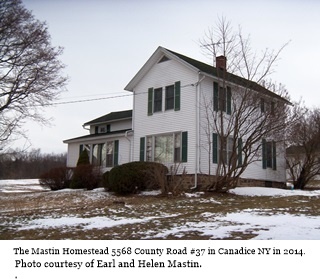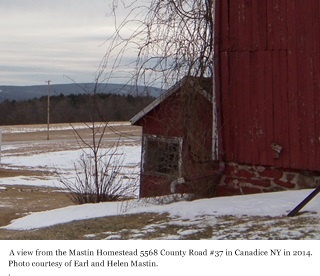
Welcome to Hemlock and Canadice Lakes!
Barns Businesses Cemeteries Churches Clinton & Sullivan Columns Communities Documents Events Time Line Fairs & Festivals Farm & Garden Hiking Homesteads Lake Cottages Lake Scenes Landscapes Library News Articles Old Maps Old Roads & Bridges Organizations People Photo Gallery Podcasts Railroad Reservoir Schools State Forest Veterans Videos
|
The Mastin Homestead in Canadice NY |
|
|
The Mastins’ Homestead Farm By Earl Mastin - The Canadice Chronicle July 1996
|
||
|
1 The Mastin Homestead in 2014. Photo courtesy of Earl and Helen Mastin. The Mastins’ Homestead Farm is located on County Road #37, about one mile north of the Canadice Methodist Church. It is bordered on the south by the Jersey Hill Road and on the east by the California Ranch property. My father purchased this farm from Gabriel and Sarah Coykendall in 1911 and moved to the farm in the spring of 1912 from his former home and farm, located about on mile south of the Canadice church. The farm consisted of 61 acres with the most of it being west of the road. Later, he bought 40 acres east of the road from Allen Huff, whose father owned the farm bordering on the south. There was a small orchard east of the road, containing about three acres which were a part of the Coykendall property. Many different varieties of apples were in this orchard. I remember when wagon loads of apples were drawn to the Apple Evaporator on Briggs Street in Honeoye and to Olin Mather’s cider mill in Hemlock. My father worked all of the land with horses until he bought a Fordson Tractor and in later years, other makes of tractors. He always kept a few cows, pigs, chickens and sheep on the farm. The milk from the cows was used by the family and was run through a separator to get cream from the milk. Mother made butter from the cream and used butter milk for baking after churning the butter. She would take crocks of butter and dozens of eggs to Gilbert’s store in Honeoye and trade them for groceries. On the land, father grew many different crops, such as wheat, oats, corn, barley and beans. After threshing the beans from the pods, the pods and vines were fed to the sheep and some of the cattle. In early days the corn was cut by hand with a sickle. Later we used a corn binder. The corn was shocked up in the field and later that fall or winter, the ears of corn were picked by hand and put in a corn crib to dry. The corn was then shelled from the cobs at the grist mill and ground into feed for the cows and pigs. Some corn was ground into a meal which made good corn bread or Johnny cake. 2 A view of the Honeoye valley from the Mastin’s. Photo courtesy of Earl and Helen Mastin. In later years the corn stalks were cut green and ground into ensilage, which was put in the silo for feed later in the year. The stalks were run through a machine called an ensilage cutter. It had a blower and a large pipe attached to it, which blew the ensilage up the pipe into the top of the silo. Some silos were as much as 40 or 50 feet tall and their diameters varied from ten to twenty feet. Neighboring farmers also had silos and changed work in filling the silos in September, before the first frost. We all enjoyed working with our neighbors at silo filling time, as we also did when threshing grain in July and August. The women prepared fine dinners for us at noon, after which we sat around for a while, telling stories and talking about old times. These are the days that a person never forgets! As time went on, my folks left the farm and moved to Honeoye, and I worked the farm on shares for about ten years, then purchased it form my folks in 1955. I was born on this farm and have lived here all my life, except for two years after Helen and I were married. We then lived in the Huff house, just to the south of our Homestead. The barn had never been painted until I purchased the farm. I had it painted four or five times since. Helen and I remodeled the house and had a bathroom and running water installed. The drinking water is piped into the house from a hand dug well about 18 feet deep. I never knew of the well going dry. We used it to cool the milk in 10 gallon cans placed in a vat, which we filled with water from the well. It tested about 40 degrees. The south part of the house is older than the rest and it was moved from east of the road and joined to the upright part of the original house. The old part dates back to the Civil War days and was a story and a half with 4x4 inch studding placed 16 inches apart and made of chestnut lumber. There is a cistern in the basement which holds two or three thousand gallons of water from the eaves. It is used for washing and bathroom purposes. The basement is about 16 feet in height and has a dirt floor, which keeps vegetables good into the winter time. This is some of the things about the old homestead which I am proud of. |
||
|
Postscript: Before Gabriel Coykendall owned the farm, it was owned by William Allison and Alfred and Sarah Thayer. A small lot on the north part of the farm was purchased from Fred Cratsley. It is now covered by the fill and the road over Affolter Gull. There was a small house on the land beside the creek, where my Grandfather and Grandma Mastin lived until they passed away.
|
||

